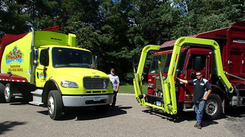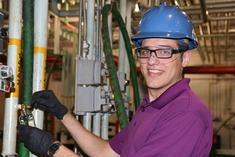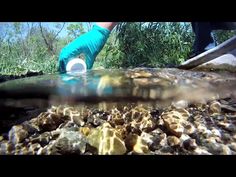|
In this issue
- Green project idea? Get a MPCA loan
-
$400,000 expected for MPCA diesel engine upgrade grants this fall
- It’s time to renew training for some painters
- MnTAP updates
- MPCA industrial stormwater updates
The MPCA offers low-interest loans for
capital projects that improve the environment. Apply for the Environmental
Assistance (EA) loan program if you’re considering a project in green
chemistry, pollution prevention, source reduction, recycling, or composting
collection. Capital costs are limited to the costs of machinery and equipment,
including freight and installation, and related improvements.
Eligible applicants include small to
medium-sized businesses and political subdivisions of Minnesota. There is
currently funding available. Since the amount available fluctuates, it is
recommended to contact the program with questions on fund availability.
The EA loan program has two types of
loans. Participatory loans provide up to $100,000 at zero percent interest with
a dollar-for-dollar match from a participating financial institution. In
addition to the interest rate charged by the institution on its matching funds,
there may be additional administrative fees. Overall though, these loans
generally have a very low interest rate. Direct loans are limited to
businesses/entities and up to $50,000 at four percent interest or one half the
prime rate, whichever is greater. Direct loans
must be matched by one dollar from the applicant for every two dollars received.
Start-up businesses are not eligible
for direct loans.
Applications are accepted on a
rolling basis. Visit the MPCA Environmental Assistance Loan Program for more information.

Got diesel? Six diesel engine projects recently were awarded $279,000 in MPCA clean
diesel grants to help replace eight pre-2007 dirty diesel vehicles. New
clean diesel engines emit at least 90 percent less of both fine particles
(PM2.5) and nitrogen oxides (NOx) – two pollutants identified by the EPA as
contributing to respiratory symptoms and triggering heart attacks in those with
heart problems.
These grants from 2015 were awarded up to 25
percent of the cost of a new vehicle. Engine replacements in off-road
construction equipment, or “repower” grants, were eligible for 40 percent of
the cost of the engine and installation. Projects funded in the 2015/2016
grant round are:
- Alex
Rubbish, Alexandria, garbage truck – $61,455
- City
of Buffalo, dump truck – $39,237
- Coolidge
Trucking Systems, St. Paul, roll-off truck – $31,603
- Misgen
Auto Parts, Ellendale, roll-off truck – $37,500
- St.
Louis County School District, 2 propane school buses – $52,630
- Viking
Coca-Cola, St. Cloud, 2 beverage delivery trucks –$56,949
Next fall, the MPCA clean diesel grant program
expects to have about $400,000. Please spread the word and encourage businesses
with heavy-duty off-road diesels (e. g. construction equipment) and class 6 or
larger on-road trucks to visit the MPCA's https://www.pca.state.mn.us/air/diesel-emissions-reduction-act-grants *
and sign up for grant updates in the upper right side of the page. Contact Mark
Sulzbach with questions at 651-757-2770 or mark.sulzbach@state.mn.us.
|

It’s
time to update painter training at businesses that are required to follow the federal
air rule known as the 6H NESHAP. This rule affects businesses that spray paint
on cars, trucks, buses, heavy duty trucks, construction equipment, and equipment
that can be pulled on a road, such as trailers. The rule requires refresher training
for painters at these types of businesses every five years.
Painters
must receive a combination of hands-on and classroom training. The training can
be in-house or painters can attend a training course. Ask your paint or
equipment vendors if they are offering 6H NESHAP refresher training. If your
painters already attend annual training, see if the 6H NESHAP refresher training
is included or can be added. If not, one option is the Iowa Waste Reduction
Center. They provide online 6H NESHAP training at www.sprayitright.com. It costs about $100, takes two hours to complete
and can be done at each painter’s own pace and schedule.
Painting
well is a skill and all skills can be improved and updated. Well-trained painters
use less paint and thinners which means more paint ends up on the product – not
on masking and filters. It also means less air pollution is leaving your shop
and the air outside is cleaner and healthier for everyone.
*written by Aneka Swanson
|

Don’t miss! 2016 Intern Symposium
Tuesday, August 23, 2016 • 1:00 p.m. - 5:00
p.m.
Johnson Great Room and Ski-U-Mah Room, McNamara Alumni Center
University of Minnesota (directions)
The MnTAP Intern Symposium features 14 intern projects at
companies around Minnesota. The interns highlight the water conservation,
energy efficiency, and waste reduction opportunities they identified during
their 3-month internships. Each presentation is 15 minutes with five minutes
for questions. A printable version of the agenda can be found here. Register Online Today!
Feature on MnTAPs degreasing assistance
The recent issue of MnTAPs Source
newsletter focuses on their efforts to reduce VOCs and hazardous air
pollutants in degreasing operations. Included are success stories,
greener products testing results we’ve tested, and a tip sheet to use when
evaluating current products or looking for a safer ones. Small degreasing
operations, such as those carried out in automotive and industrial cleaning,
are estimated to add 14% of all industrial VOC air pollution in Minnesota. Also
included is a summary of MnTAP's 2015 projects and results, and a look at
other projects currently in the works.
|

The current general permit was issued April 2015, and all
permittees were required to “restart” sampling quarterly, for four quarters to
start, starting July 2015. New applicants started sampling the next full
calendar quarter after receiving permit coverage.
This means that June 30, 2016 marks the end of
the first four quarters of industrial stormwater sampling requirements for most
permittees.
Did you collect samples during four separate
quarters? If not, continue sampling. If you were able to collect
stormwater samples from four different quarters during the past year, calculate
the rolling average value of each parameter’s monitoring results and compare
with the benchmark values listed in the general permit. If your average value is
less than the benchmark value, you’re done monitoring for that parameter.
If your average value is more than the benchmark value, continue sampling until
your averaged values fall below the benchmark values.
The concept of “the rolling average” is new for
the 2015-2020 general permit. Make sure you are averaging the sample
results from the four most recent quarters, and compare those with the general permit values. If no sample was
collected for a quarter, send in the sampling form with a "No Flow"
explanation. In the example below, no sample was collected in Quarter 5
and Quarter 10, and the permittee needs to collect only one sample during the
following quarter. You no longer have to "collect two samples in the
next quarter to make up for not being able to collect samples the previous
quarter" as required in the 2010-2015 permit. This example below is
for Total Suspended Solids (TSS), with a permit benchmark value of 100 mg/L.
Use this handy “Industrial Stormwater Sampling Worksheet” to
help you record and review your sampling data. Previously, we had “sampling
results” and "sampling calendars” on our website to let permittees know if
they had to continue sampling. Due to our agency-wide data system
upgrade, that functionality is currently not available but we are working on
bringing that functionality back. If you are unsure whether or not you
have to continue sampling, please contact any industrial stormwater technical
staff and we’ll be happy to help you.
No exceedances? No problem!
Were you below the permit benchmark values for
all of your parameter(s) at all of your monitoring location(s) You do not need
to notify the MPCA that you’re “done” with the sampling requirements.
Keep the individual and averaged results documented within your Stormwater
Pollution Prevention Plan.
*as featured in the June 2016 edition of the MPCA Industrial Stormwater News
|
|